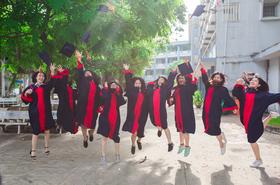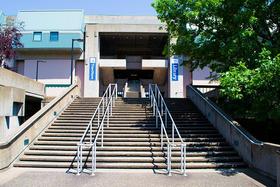- Cypress College enriches students'lives by providing high-quality education for transfer to four-year institutions, associate degrees, vocational training, and certificate coursework, as well as basic skills and opportunities for lifelong learning. The college is committed to promoting student learning and success, embracing diversity, contributing to the economic and social development of the surrounding community and being open to all qualified students pursuing their educational goals.
School Highlights
Cypress College serves 18,806 students (28% of students are full-time).
The college's student-teacher ratio of 33:1 is higher than the state community college average of 32:1.
Minority enrollment is 87% of the student body (majority Hispanic), which is more than the state average of 77%.
Quick Facts (2025-26)
- Enrollment: 18,806 students
- In-state tuition: $1,138
- Out-state tuition: $6,226
- Student-teacher ratio: 33:1
- Minority enrollment: 87%
- Source: Verified school update
Top Rankings
Cypress College ranks among the top 20% of public schools in California for:
Category
Attribute
Community Size
School Overview
The teacher population of 572 teachers has stayed relatively flat over five years.
Cypress College
(CA) Community College Avg.
Carnegie Classification
Baccalaureate/Associate's Colleges: Associate's Dominant
Baccalaureate/Associate's Colleges: Associate's Dominant
Institution Level
Four or more years
At least 2 but less than 4 years
Institution Control
Public
Public
Total Faculty
572 staff
315 staff
Student Body
The student population of Cypress College has grown by 19% over five years.
The student-teacher ratio of 33:1 has increased from 27:1 over five years.
The Cypress College diversity score of 0.67 is less than the state average of 0.70. The school's diversity has stayed relatively flat over five years.
Total Enrollment
18,806 students
9,796 students
Student-Teacher Ratio
33:1
32:1
# Full-Time Students
5,213 students
1,259 students
# Part-Time Students
13,593 students
8,537 students
# Enrollment Undergraduate
188 students
242 students
# Full-Time Undergraduate Students
5,213 students
1,250 students
# Full-Time Graduate Students
n/a
63 students
# Part-Time Undergraduate Students
13,593 students
8,299 students
# Part-Time Graduate Students
n/a
10 students
Total Dormitory Capacity
n/a
121 students
% American Indian/Alaskan
n/a
n/a
% Asian
25%
13%
% Hispanic
50%
47%
% Black
4%
7%
% White
13%
23%
% Hawaiian
n/a
1%
% Two or more races
6%
5%
% Non Resident races
1%
1%
% Unknown races
1%
3%
Diversity Score
0.67
0.70
College Completion Rate (Students who graduate in less than 4 years)
36%
28%
College Completion Rate (Students who graduate in 4 years or more than 4 years)
34%
43%
Average Graduate Earnings (10 Years)
$37,900
$34,700
Tuition and Acceptance Rate
The public in-state tuition of $1,138 is less than the state average of $1,516. The in-state tuition has stayed relatively flat over four years.
The public out-state tuition of $6,226 is less than the state average of $6,779. The out-state tuition has declined by 30% over four years.
In-State Tuition Fees
$1,138
$1,516
Out-State Tuition Fees
$6,226
$6,779
Tuition Notes
$46 per unit (Waived for CCPG recipients)
% Students Receiving Some Financial Aid
87%
85%
Median Debt for Graduates
$10,500
$10,500
Median Debt for Dropouts
$6,394
$6,239
Acceptance Rate
n/a
93%
Source: 2024 (or latest year available) Integrated Postsecondary Education Data System (IPEDS) , School Administrators
School Notes
- The College is composed of twelve major instructional buildings located on a 110-acre site. The campus buildings contain conventional classrooms as well as laboratory facilities for science, art, computer technology, photography, automotive services, dental clinic, mortuary science, physical education and other specialized programs. The Educational Services and Roosevelt Center provide opportunities for students with disabilities to be fully integrated into various college programs. In addition to our fine academic and vocational programs, we offer many support services to help students succeed: study skills classes, tutoring, learning centers, counseling, financial aid, and health services, to name a few. Students can also participate in student government activities, special interest clubs, athletic teams, and fine arts productions. Since its inception, the Cypress College Foundation has raised nearly $3 million in support of the college. Over the years that support has included student scholarships, book loans, department grants, major equipment purchases, the comprehensive renovation of the Mortuary Science building and more. Click here to visit the Cypress College Foundation. Cypress, which offers seven sports for women and six for men, has had a solid line-up of teams and individual athletes who have excelled since the college first opened its doors in 1966. In recent years, the baseball, softball, women's soccer and women's basketball programs have taken center stage.
Frequently Asked Questions
How much does Cypress College cost?
Cypress College's tuition is approximately $1,138 for In-State students and $6,226 for Out-State students.
What is Cypress College's ranking?
Cypress College ranks among the top 20% of community college in California for: Largest student body.
Recent Articles

How to Transfer from Community College to a Four-Year University in 2025
A step-by-step guide for community college students transferring to a four-year university in 2025 — updated strategies, data and expert insights.

Scholarships for Community College Students 2025
Explore updated scholarship programs, tuition data, and expert strategies for community college students in 2025.

The Rise of Technical and Vocational Training in 2025
Explore the 2025 surge in technical and vocational training—enrollment, policy, costs, and why this path is gaining ground for students and parents.










